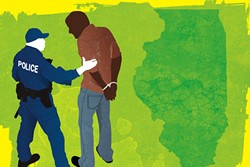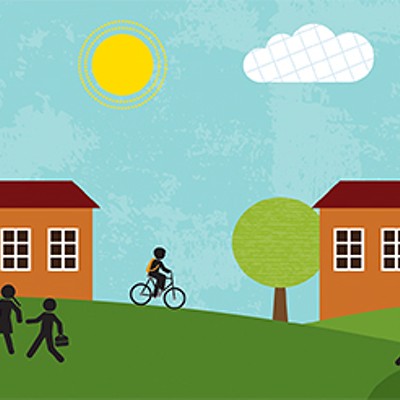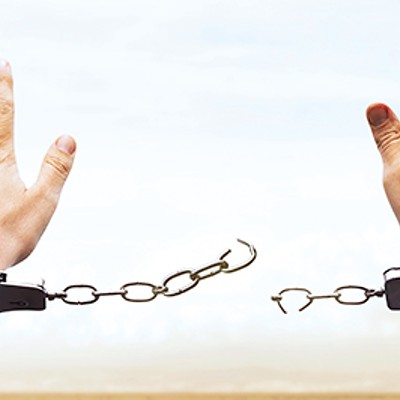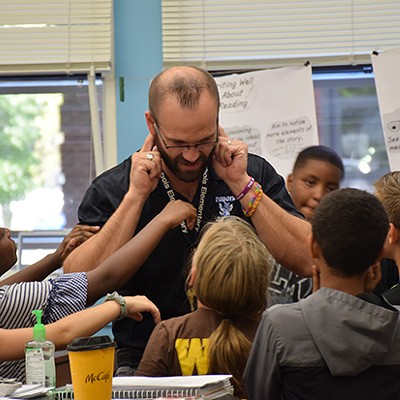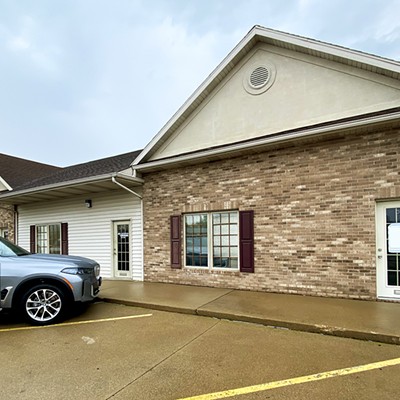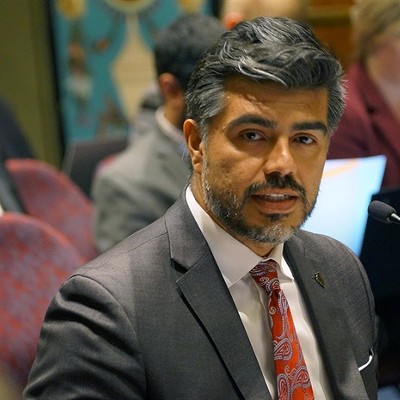Sunshine Clemons was in high school when she had one of those formative experiences nearly every black person has involving police.
Clemons, who lives in Springfield, says she and a couple of her fellow black friends were pulled over while driving in southern Illinois, ordered out of the car, restrained with zip ties and forced to kneel on the side of the highway in the rain while the police searched their car.
“They thought we were up to something,” Clemons said.
The teens were eventually let go, but the officers admonished that they were taking a beer bottle cap they found in the trunk as evidence.
“My experiences are the same as many other [black] people,” Clemons said. “It just kind of becomes what we deal with. We can’t let every instance bring us down, because we would never find happiness if we let the actions of others and stereotypes tear us down.”
Clemons is starting a Springfield chapter of the nationwide protest group Black Lives Matter, which formed as a response to police killing black people. The local chapter is the latest to join several Springfield organizations in a dialogue meant to counter institutional racism, build relationships and prevent a similar tragedy from happening here.
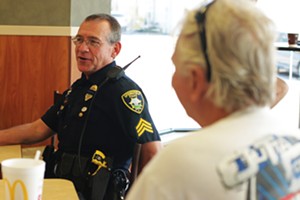
The problem
Michael Brown’s fatal shooting in 2014 by a police officer in Ferguson, Missouri, helped bring to the surface a long-festering tension between police and communities of color. Brown’s killing, though ultimately ruled justified by the U.S. Department of Justice, forced the country to contend with the fact that black people are proportionately more likely to be stopped by police and more likely to be killed in such encounters.
Since Brown’s death, several other cases have gained national attention involving black people either being killed by police or dying while in police custody. Many of those cases began as routine stops over minor issues and quickly escalated.
Following two such cases earlier this month – those of Alton Sterling and Philando Castile – retaliatory attacks on police in Dallas and Baton Rouge resulted in a combined eight officers killed.
The growing anger and distrust toward police is a symptom of a larger problem in America: racism didn’t die with the banning of slavery or the end of Jim Crow laws. Although outright racism is widely condemned, a more insidious form called institutional racism thrives.
Institutional racism is the abuse of power by some system based on racial prejudice. In a nutshell, it’s institutions like banks, the media or law enforcement treating white people one way and everyone else another way – usually not out of malice, but simply because those systems were created by and for white people. As a result, white people typically benefit from privileges that non-white people don’t enjoy.
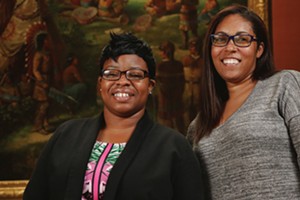
Vanessa Knox of Springfield says one such privilege is how white people are represented in popular culture. Knox is co-chairwoman of Communities United for Justice and Order, a restorative task force within the Springfield-based Faith Coalition for the Common Good. She says cultural representations of different groups matter because they form the basis of our beliefs about what is normal and good.
“If your parents only exposed you to people that look exactly like you, and that’s all you’ve ever been around, then you turn on the TV, you’re going to think that blacks are the most vicious, violent people you’ve ever seen in your life,” she said. “The images of what the media give you severely affect you.”
Knox says being black has consequences for her any time she drives a car or does any number of other routine activities in public. Although she works two jobs and dresses professionally, she says she is often followed around by store clerks.
Clemons say that black people are “an oddity” in America – overrepresented in sports and entertainment, but underrepresented in textbooks. Meanwhile, white people see themselves represented and reflected in most aspects of culture.
“When you are the face of what is considered right, your face is on TV all the time, your face is in books, your face is generally the police officer,” she said. “You don’t see our faces in textbooks unless they’re talking about slavery or something in Africa.”
When cultural representations are left unexamined or untempered by personal relationships, they lead to stereotypes, which affect how people view and treat one another. That can be seen in the interaction between people of color and law enforcement.
The police perspective
Sergeant Gerry Castles is a white, 26-year law enforcement veteran, serving with the Springfield Police Department for the last 22 years. He sees his role as that of a parent – sometimes enforcing rules, but just as often providing guidance and a helping hand. He tells the story of a young man in Springfield whom he met on the job. The young man sells dope, Castles says, but he lies awake at night worrying that each day will be his last.
“He doesn’t want to do it, but he has no other way to pay the rent,” Castles said.
He adds that it’s easy to say the young man should just get a real job, but no one has modeled that behavior for him.
“Even something as simple as filling out an application – we have to open our minds and realize that maybe they don’t know how to do this,” Castles said. “It has nothing to do with intellect or intelligence; it has to do with what their environment was. If it’s easy to take $100 worth of powder cocaine and turn it into X amount of dollars, that’s what you do.”
Thoughtful and funny at the same time, Castles has no problem defending law enforcement in one breath and pointing out its shortcomings in the next.
“What frustrates me is this mantra that when an officer goes through his police training, then his moral code, whatever his parents taught him, his filtering system all go out the window, and he becomes this monster who’s out to kill people,” Castles said. “It’s ridiculous to think that.”
The job of policing requires officers to go into ambiguous situations with little or no information about what to expect, Castles says. Often, what little information an officer has is one-sided or completely wrong.
“You prepare for this every time you go through a door,” Castles said, putting his hands in a boxing pose, “but you can’t look like this.
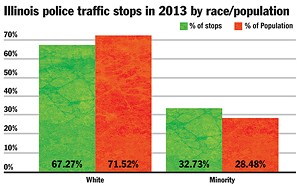
“You have to look like this,” he said, lowering his hands and plastering a smile on his face to seem nonthreatening. Castles says he prefers to use words to resolve conflict, and even when he has to use force, he tries to explain why to the person afterward.
Still, he says having to always be ready to defend against an attack can leave officers on edge, and no officer wants to be the one who failed to catch a criminal because the officer didn’t investigate a suspicion. Castles recalls an incident that happened more than 20 years ago, in which four men robbed a hotel in Springfield. Just after the robbery, Castles saw a car drive by with four men inside staring directly at him. He didn’t stop the car because there was no information available on potential suspects at the time.
“To this day, I know that was them,” he said, a hint of regret in his voice.
Although Castles is discouraged that police are sometimes seen as “the bad guys,” he says he understands why. For one thing, he says, law enforcement is an evolving science that sometimes changes only when an incident or string of incidents reveal a problem. Castles says police training and standards differ from state to state, so not all departments operate the same way.
He also notes that the history of racism has, at times, been intertwined with law enforcement.
“We’re not that far removed from race riots in the ’60s,” he said. “When we think of the racism in the South during the ’50s and ’60s, some of the perpetrators and Klan members were cops. So, I understand how that thought process gets in there. Don’t think that’s not discussed from generation to generation. I see where that seed of distrust [toward police] comes from.”
Sometimes, Castles says, wearing his uniform gets tiresome. He can often feel the stares of bystanders at a crime scene, some of them likely seeing him only as a police officer and an enemy instead of as a person.
“When it rises to the level of you see my uniform and you pass a judgment on me, how is that any different from what you accuse me of?” he said. “You can’t measure my heart behind this uniform, my moral code.”
Springfield police chief Kenny Winslow knows that feeling, too. He was off duty in a restaurant with his young son when he heard about the July 7 attack in Dallas that killed five police officers and wounded seven more. Nearby, Winslow heard someone remark that there should be many more dead officers.
“I was taken aback,” he said. “It was not only the tragedy I saw on TV, but the tragedy I saw in that restaurant. That kind of hate is taught. … I hope that what comes out of Dallas is that we in law enforcement realize that we’re all human; we’ve got to work together. We don’t want to see this put us back into the throes of 1964. There’s got to be mutual respect.”
The data
Spurred by serious shortcomings in how the FBI collects data on fatal shootings by police (FBI director James Comey called the system “embarrassing and ridiculous”), the Washington Post began collecting its own data on every fatal shooting by police in 2015 and 2016. The Post’s data shows 990 people fatally shot by police in 2015. At publication time, the database showed 533 people fatally shot so far in 2016.
Of the 990 deaths recorded by the Post for 2015, 494 (51.4 percent) were white, and 258 (26.8 percent) were African-American. White people make up 73.4 percent of the U.S. population, according to census data for 2014, while black people make up 12.7 percent of the population. (Most of the remaining 21.8 percent are classified as Hispanic in the Post’s database, but it’s difficult to compare that with the general population because the U.S. Census treats Hispanic ethnicity as separate from race.)
An independent study of the Post’s data by a team of criminal justice researchers found that, after adjusting for factors like age, mental illness and whether the person killed was armed and attacking someone, black people who were unarmed were more likely to be killed than unarmed white people.
Justin Nix, a criminal justice researcher at the University of Louisville, worked on the study.
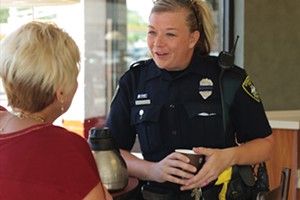
“The only thing that was significant in predicting whether someone shot and killed by police was unarmed was whether or not they were black,” Nix is quoted telling the Washington Post.
Critics say tallying fatal shootings by police isn’t a good measure of whether police treat people of color differently because the vast majority of interactions with police don’t result in fatal shootings. While there is no database of all police-public interactions nationwide, Illinois has been collecting data on traffic stops since 2004. The data is limited to Illinois, but it provides a somewhat broader scope than fatal shootings alone can offer.
Collected by most police agencies around the state and reported to the Illinois Department of Transportation, Illinois’ traffic stop data covers more than 25.7 million stops from 2004 to 2014. According to the data, white people accounted for 67.3 percent of all stops on average during that 11-year period, but they accounted for 71.5 percent of the state’s driving population. By comparison, minority drivers – all people not categorized as white – accounted for 32.7 percent of all stops but only 28.5 percent of the driving population.
Over the same period, minority drivers were also held longer than white drivers during stops, were more likely to be given tickets and were more likely to be searched, yet less likely to be found with contraband.
While police say there are reasons for more stops of minority drivers, such as more patrols in high-crime areas, the effect remains the same: more chances for people of color to have negative experiences with law enforcement, leading to higher chances of incarceration or death.
The Springfield solution
Springfield has a history of racial conflict. Abraham Lincoln’s neighbor in Springfield, a free black man named Jameson Jenkins, sheltered people fleeing slavery at great peril to himself. Springfield’s race riot of 1908, in which at least two black people were killed and numerous black homes and businesses were destroyed, spurred the creation of the NAACP. The city’s mayor-council form of government is the result of a 1985 civil rights lawsuit that showed the former commission form of government disenfranchised black citizens. In 2009, former City Water, Light and Power employee Mike Williams found a noose hanging at his work station.
Those are just some of the more memorable examples. That history remains in the forefront of many minds in Springfield, spurring several groups to meet the problem head-on.
The Springfield Police Department is lauded by several local groups for taking an active approach to dealing with the racial divide. Winslow, the police chief, says his agency’s efforts are not so much a program as a philosophy called community policing. Essentially, community policing is about building relationships.
“One of our goals is to be able to build trust,” he said. “You’ve got to have trust to have a relationship. That helps build partnerships, which directly affects our ability to carry out our mission.”
The SPD’s neighborhood police officers are the most visible example, in which a beat cop is assigned to a certain neighborhood, getting to know its residents, its geography and its issues. Winslow and his officers also walk each neighborhood in the city, knocking on doors to meet people and make their faces more familiar. They hold informal meet-ups around the city so residents can bring up concerns or just chat. They go to after-school programs to mentor young people. They talk to young athletes about how to stay out of trouble. They even hold meetings about what to expect and how to act during a traffic stop.
It works, Winslow says, because it’s a consistent effort, and because it’s not just done when there’s been an incident. He points to the July 11 shooting of a black man by a Decatur police officer. The police there already had relationships with local black leaders, Winslow says, so there was enough mutual trust to prevent additional violence.
Winslow recalls walking a predominantly minority Springfield neighborhood, which he said was “one of the roughest areas in town.”
“If you’d have asked me going into that how much support we’d have, I would have guessed 40 to 50 percent; I would have been happy with 50 percent,” he said. “Overall, I was shocked by how much support we had.”
The police also partner with other groups in Springfield. One such partnership is with the Springfield Race Unity Committee, which brought the documentary Racial Taboo to be screened in Springfield. The film discusses the thread of racism through American history and the difficulty the nation has with addressing it. In April, the entire Springfield Police Department attended a screening of the film and afterward participated in small group discussions with members of the public.
Mike Lang, a member of SRUC, says the majority of police officers felt it was worthwhile.
“It’s really a simple concept, the whole idea of sitting down and talking with people of different backgrounds,” he said.
The Springfield Race Unity Committee began about 20 years ago as a collaboration between the mostly black Springfield Ministerial Alliance and the mostly white Greater Springfield Interfaith Association. The group holds regular “Constructive Conversation” discussions about race. Lang says the recent violence has only made those discussions more relevant.
“Everybody’s crying out that it’s time to learn how to get along, to learn how to love and respect each other,” he said.
The Springfield Coalition on Dismantling Racism, called SCoDR for short, has a similar aim. It began about four years ago out of discussions on race between the Dominican Sisters of Springfield, the Greater Springfield Chamber of Commerce and other groups. An outgrowth of efforts the Dominican Sisters have made for the past decade to root out institutional racism within their organization, SCoDR holds weekend “trainings” on recognizing institutional racism and countering it. The sessions are led by Crossroads Antiracism Organizing and Training, based in Matteson, Illinois, and SCoDR’s efforts have resulted in employees with the city, Springfield Public Schools, and several other local organizations going through the training.
Sunshine Clemons, who is starting a Springfield chapter of Black Lives Matter, says her group is still forming, but she anticipates taking part in regular conversations with the Springfield Police Department to find common ground.
Vanessa Knox with Communities United for Justice and Order, says that, among other things, the group wants to address mass incarceration. The state and national prison populations are disproportionately black, stemming partly from inequalities in arrests and sentencing. Currently in Springfield, people released from prison receive little help reintegrating into society, Knox says.
“These guys, especially the nonviolent offenders, need more support so that they don’t go back to the old life,” she said. “That’s the stereotypical ‘black guy goes to jail, dad went to jail, grandpa went to jail.’ ”
CUJO and its parent organization, the Faith Coalition for the Common Good, focus on several issues in Springfield and central Illinois which deal with racial inequality and social justice.
Despite its devotion to building relationships, the Springfield Police Department still has work to do. For example, the department consists mostly of white men, which doesn’t reflect the population of the city. According to an internal audit of the city’s workforce released on April 15, there were 242 sworn officers in the department at the time. Of those, 20 were non-white and 27 were female.
Winslow encourages more people of color and women to apply to the department. He says that although the standards are quite strict, he prefers that people be honest about their past when applying.
“There are no perfect people out there; there are none,” Winslow said. “But man up or woman up, and tell me the truth. We need good morals and values, good work ethic, an open mind and the ability to learn. We’ll teach you everything else you need to know.”
Both Knox and Clemons praise the efforts of the Springfield Police Department but say there is always room to build more trust.
“It’s important to have these conversations because it leads to change,” Clemons said. “You don’t just jump into change. It’s important to include cops in this because they’re a vital part of what we’re trying to do here. They can be part of the solution.”
Contact Patrick Yeagle at [email protected].

